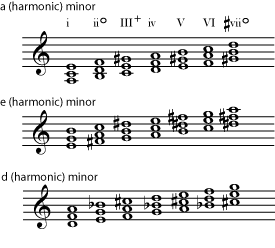| << Chapter < Page | Chapter >> Page > |
Look at the chords in [link] . What note of each scale would have to be changed in order to make v major? Which other chords would be affected by this change? What would they become, and are these altered chords also likely to be used in the minor key?
The seventh degree of the scale must be raised by one half step to make the v chord major. If the seventh scale note is raised, the III chord becomes augmented, and and the vii chord becomes a diminished chord (based on the sharp vii rather than the vii). The augmented III chord would not be particularly useful in the key, but, as mentioned above , a diminished seventh chord based on the leading tone (here, the sharp vii) is sometimes used in cadences .

The point of the harmonic minor scale is to familiarize the musician with this common feature of harmony, so that the expected chords become easy to play in every minor key. There are also changes that can be made to the melodic lines of a minor-key piece that also make it more strongly tonal. This involves raising (by one half step ) both the sixth and seventh scale notes, but only when the melody is ascending. So the musician who wants to become familiar with melodic patterns in every minor key will practice melodic minor scales, which use different notes for the ascending and descending scale.
You can begin practicing harmonic analysis by practicing identifying whether a piece is in the major key or in its relative minor. Pick any piece of music for which you have the written music, and use the following steps to determine whether the piece is major or minor:
Sometimes a piece of music temporarily moves into a new key. This is called modulation . It is very common in traditional classical music; long symphony and concerto movements almost always spend at least some time in a different key (usually a closely related key such as the dominant or subdominant , or the relative minor or relative major ), in order to keep things interesting. Shorter works, even in classical style, are less likely to have complete modulations. Abrupt changes of key can seem unpleasant and jarring. In most styles of music, modulation is accomplished gradually, using a progression of chords that seems to move naturally towards the new key. But implied modulations, in which the tonal center seems to suddenly shift for a short time, can be very common in some shorter works (jazz standards, for example). As in longer works, modulation, with its new set of chords, is a good way to keep a piece interesting. If you find that the chord progression in a piece of music suddenly contains many chords that you would not expect in that key, it may be that the piece has modulated. Lots of accidentals, or even an actual change of key signature , are other clues that the music has modulated.
A new key signature may help you to identify the modulation key. If there is not a change of key signature, remember that the new key is likely to contain whatever accidentals are showing up. It is also likely that many of the chords in the progression will be chords that are common in the new key. Look particularly for tonic chords and dominant sevenths. The new key is likely to be closely related to the original key, but another favorite trick in popular music is to simply move the key up one whole step , for example from C major to D major. Modulations can make harmonic analysis much more challenging, so try to become comfortable analyzing easier pieces before tackling pieces with modulations.
Although the concept of harmonic analysis is pretty basic, actually analyzing complex pieces can be a major challenge. This is one of the main fields of study for those who are interested in studying music theory at a more advanced level. One next step for those interested in the subject is to become familiar with all the ways notes may be added to basic triads. (Please see Beyond Triads for an introduction to that subject.) At that point, you may want to spend some time practicing analyzing some simple, familiar pieces. Depending on your interests, you may also want to spend time creating pleasing chord progressions by choosing chords from the correct key that will complement a melody that you know. As of this writing, the site Music Theory for Songwriters featured "chord maps" that help the student predict likely chord progressions.
For more advanced practice, look for music theory books that focus entirely on harmony or that spend plenty of time analyzing harmonies in real music. (Some music history textbooks are in this category.) You will progress more quickly if you can find books that focus on the music genre that you are most interested in (there are books specifically about jazz harmony, for example).

Notification Switch
Would you like to follow the 'Introduction to music theory' conversation and receive update notifications?